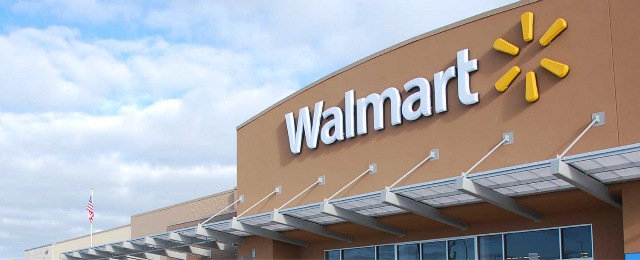Wall Street Has Low Expectations For Next Wal-Mart Earnings Report
by August 17, 2015 8:18 am 162 views

When Wal-Mart Stores reports its second quarter earnings on Tuesday (Aug. 18), the story will be about a lot of things: Walmart wages; the terrifically cumbersome job of redirecting the world’s largest retailer; the upfront investment and questions about long-term payoff involved in that redirection; and consumer spending, China, and consumer spending in China.
The retailer is expected to see net profits between $3.6 billion and $3.7 billion for the quarter ended July 30. Net income in the same period of last year was $4.093 billion.
Wall Street consensus for the big box retail giant is $1.13 cents per share, which would be 6.6% less than the $1.21 per share it earned a year ago. Most analysts are cautious when it comes to Wal-Mart performance given the investments in wages, training and e-commerce fulfillment announced in February by CEO Doug McMillon.
The $1 billion investment for higher worker wages and better training, coupled with the opening of two new online fulfillment centers is expected to shave between 29 cents and 31 cents from the retailer’s total 2015 earnings. This comes on top of a projected $14 billion top-line drag from currency translation.
The sentiment from a Thomson Reuters poll found a low estimate of $1.06 per share, while Budd Bugatch with Raymond James & Associates had a bullish view of $1.16 per share. Ben Bienvenu, retail analyst with Stephens Inc., has a $1.11 per share estimate.
The one area that analysts seem to agree on is tepid comparable sales forecast at 1% for Wal-Mart U.S. and Sam’s Club, without fuel impact. With fuel impact, most experts believe Sam’s Club could see another negative comp sales number for the second quarter.
Bienvenu said revenue will be pressured from deflationary pricing in key categories like electronics and food commodities in addition to the foreign exchange hit. Consensus revenue for the quarter ended July 30, is expected to be $119 billion, down slightly from the $120 billion reported a year ago. The revenue predictions per segment are: $73 billion – Walmart U.S.; $31 billion – Sam’s Club; and $15 billion – International.
“The investments Wal-Mart has made are critical for the longer term, though they do present some near term pressure. If they are going to turn around profits overall, this attention to supercenters and Neighborhood Market operational details and higher wages is needed,” Bienvenu told The City Wire.
He likes Wal-Mart’s strategy to shift more autonomy to store managers, adding that Wal-Mart does a good job leveraging expenses, if not sometimes a little too far in the case of store management personnel.
Stephens and Raymond James give Wal-Mart shares (NYSE: WMT) a “buy” rating noting that the price has been hammered down this year. Bienvenu said at around $72 per share, Wal-Mart is attractive given its dividend. He said if management can show improvement in key metrics the price should have room to run higher.
Bugatch also believes Wal-Mart has upside potential noting that the price “remains well below our $85 to $86 calculations of intrinsic value. Our assessment that the risk/reward of this mega-cap issue now strongly favors reward over incremental price risk, given that most, if not all, of the bad news seems known and baked into the current price.”
CHINA’S UPSIDE
Wall Street also sees Wal-Mart as having upside potential with the recent devaluation of the Chinese currency, primarily because it’s a move that lowers the import price on goods made in China.
“I have not been a fan of Wal-Mart but at these price levels the stock bears watching,” said CNBC contributor Jim Cramer. During a Squawk on the Street segment Wednesday, (Aug. 12) he said “CEO Doug McMillon is trying to turn things around, but it’s not easy.” He said goods are now as much as 15% cheaper in China and Wal-Mart could see a boost given its buying power and likely improved margins.
“I think we know Wal-Mart gets bulk discounts,” he said.
Cramer said the cheaper Chinese goods also is a positive for the U.S. consumer on top of the added savings they continue to get in gasoline prices.
Bienvenu also sees upside in China. He said the recent increased stake in Yihaodian by Wal-Mart is a longer-term growth strategy, but is important as more Chinese retail sales go online. Wal-Mart bought the remaining 49% of Yihoadian on July 22 from the financial services group Ping An of China. Terms of the deal were not disclosed.
Yihaodian has more than 100 million registered customers, and more than 8 million products on offer, according to Wal-Mart.
“Yihaodian has excelled as one of China’s top e-commerce businesses… Our investment in Yihaodian is part of our long-term commitment to grow in China, and we look forward to continuing to play a positive role in the development of the e-commerce industry,” Neil Ashe, president and CEO of Walmart Global eCommerce said July 22.
SHARE PERFORMANCE
Wal-Mart shares have had a disappointing run in 2015. The stock price is down more than 16% year-to-date, losing 8.4% in the past three months alone.
In contrast, the S&P 500 is up slightly at 1.14% year-to-date and the Dow Jones Industrial Index is down 2%. Wal-Mart, a Dow Jones component, has been one of the weaker performers in the first half of 2015.
Analysts who use a technical approach note that Wal-Mart has taken the shape of a falling wedge pattern testing lows at the $70 range. The price movement has been a one-way street to the downside as shares tumbled from a 52-week high price of $90.97 to $70 several times before recent upticks to around $72.
Technical analysts believe that if Wal-Mart could report positive news on the consumer front and show improved traction in efforts to turn around sagging supercenter comp sales, the stock has room to move higher and stay higher.
